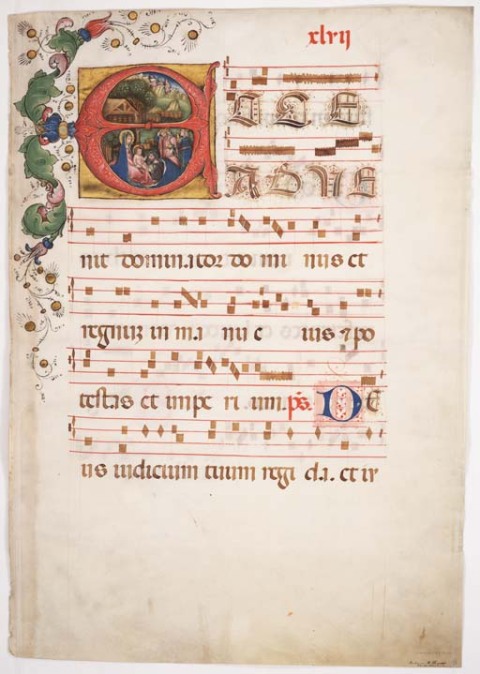Epiphany, January 6 (Lombardy, 1490-1510)
April 24, 2009
Single leaf from a gradual:
Initial E with the Adoration of the Magi, January 6
Lombardy, Italy, 1490-1510
Script: Rotunda
Parchment with ink, paint, and gold
Notation: Square
This initial begins the introit for the Feast of the Epiphany: Ecce advenit Dominator Domine (Behold, He is come, the Lord the Ruler).
The leaf shown here has perspective and detail that is not displayed in earlier illustration processes. The Star in the East is prominent in the picture, as is one of the adoring kings, who is quite literally in the very center of the initial. However, attention is appropriately paid by all other figures in the foreground to the baby Jesus. There is a ship in the background, which might signify an escape plan: God warned them in a dream “that they should not return to Herod, they [should depart] into their own country another way” (Matthew 2:1). The initial is clearly a product of the early Renaissance period, as the artist has clothed the subjects of this decoration with heavy gowns and sleeves of the 15th century, donned the soldiers in the background with armor of that period, and painted a ship with a 15th-century gallery and mast.
Free Library of Philadelphia Lewis E M 71:15
Epiphany, January 6 (Northern Italy, c. 1400-1415)
April 24, 2009
Single leaf from a gradual: Initial E with the Adoration of the Magi
Northern Italy – c. 1400-1415
Script: Rotunda
Parchment with ink, paint, and gold
Notation: Square
This initial begins the Introit for the feast of Epiphany (Jan.6), “Ecce advenit dominator dominus …” (Behold, the Lord the Ruler is come). Here we have an example of more advanced technique in medieval art: there is a background and scenery with some perspective. There are out-of-scale heads over the hills in the background that are probably supposed to be shepherds in the distance, although they appear as garden gnomes carved into the side of a mountain perhaps, from our modern viewpoint.
The artist of this historiated initial is possibly a predecessor to Peronet Lamy, a Savoy artist who illuminated a full page miniature in the Morgan Library in New York, M. 180, a lectionary written by Johannes de Monterchio of Padua for Pietro Donato, bishop of Padua (1428-1447).
Free Library of Philadelphia E M 71:9

